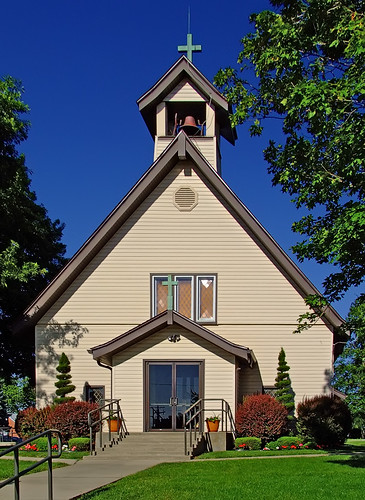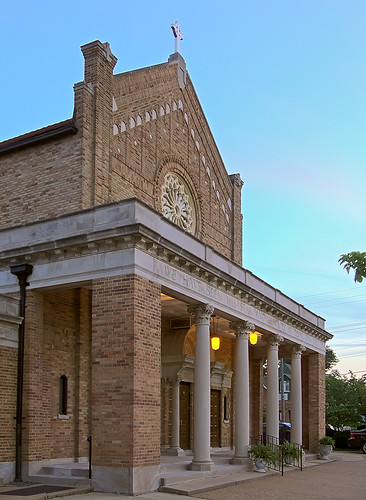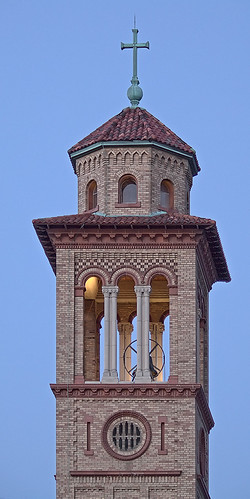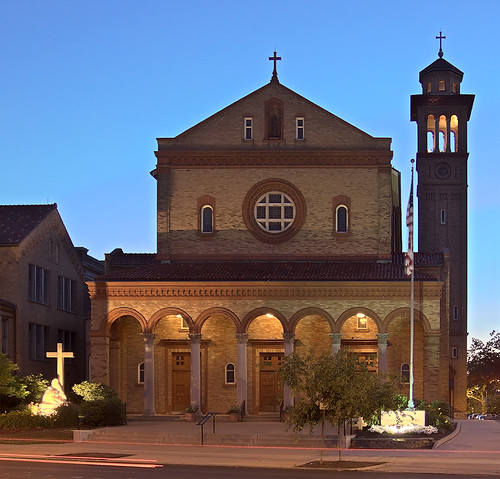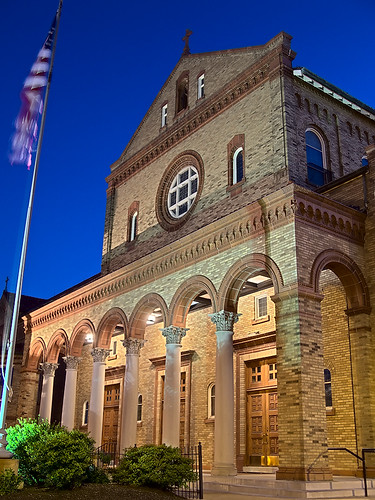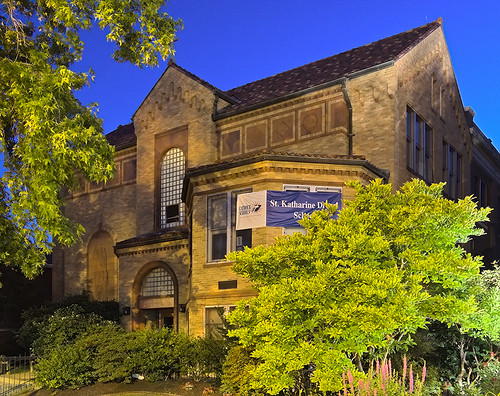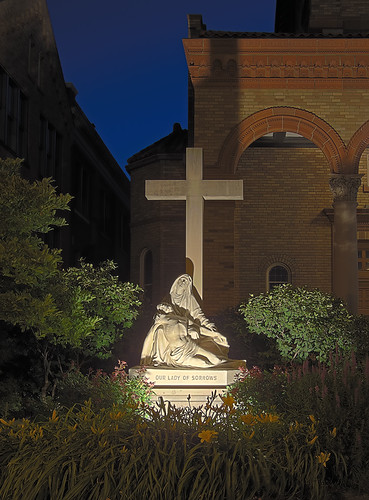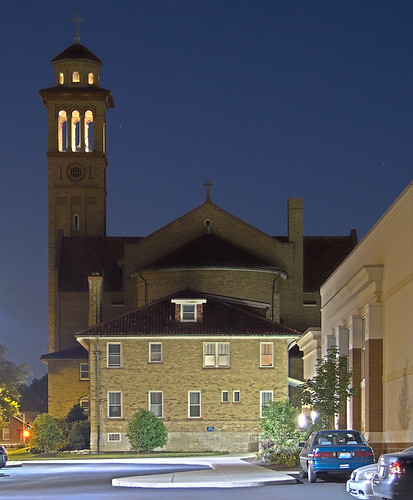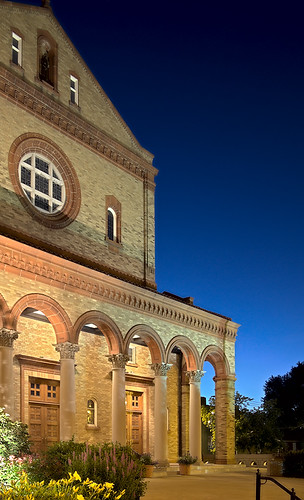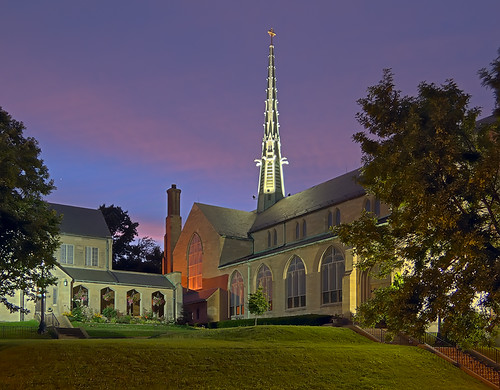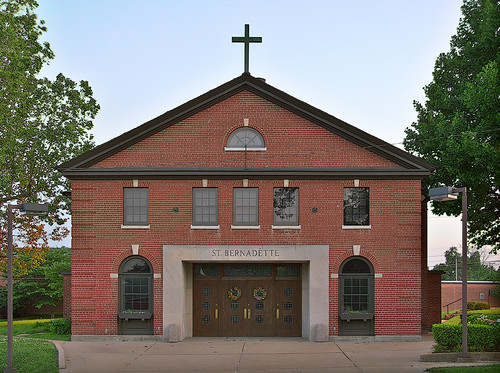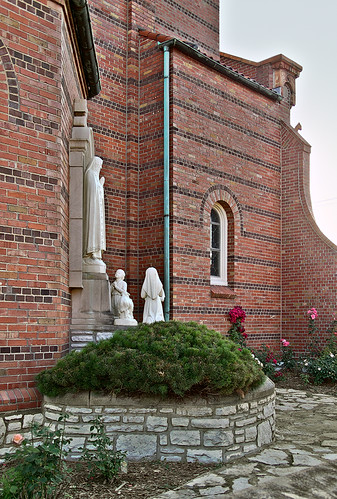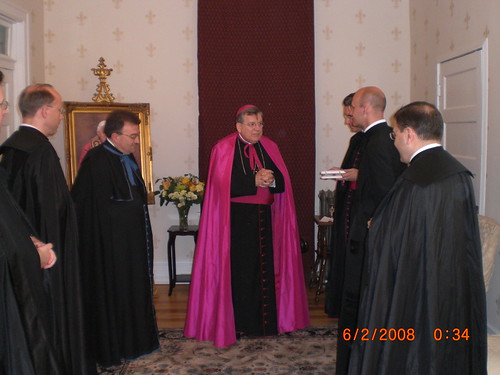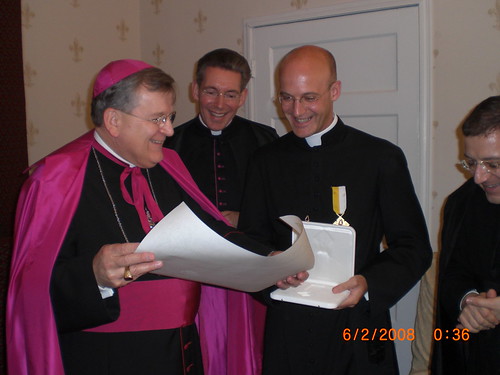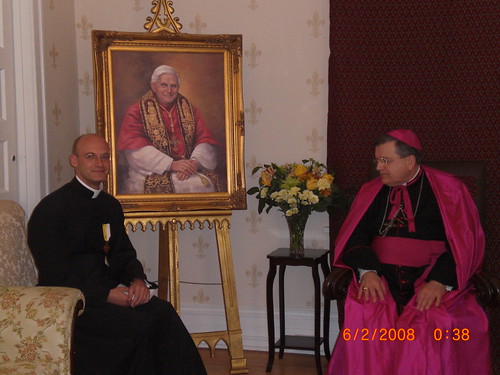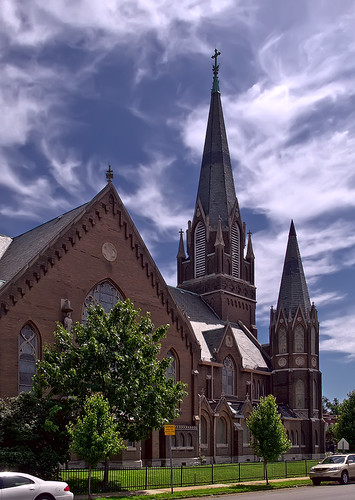
Sunday, June 29, 2008
Friday, June 27, 2008
"The most influential American in Rome"
Farewell, Archbishop!
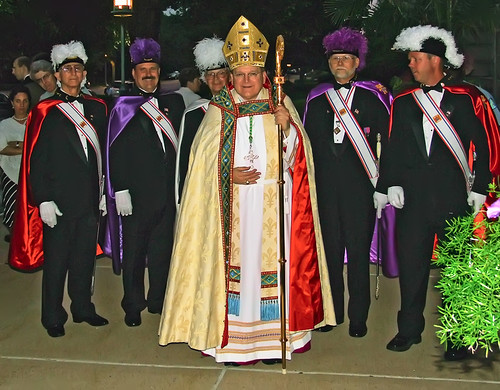
Archbishop Burke with his Knights of Columbus Honor Guard; photo taken on the Feast of Corpus Christi, 2007.
In 1968, the world changed. In 1967, what was called the "Summer of Love" turned into the summer of hatred and revolution a year later. In 1968, the encyclical Humanae Vitae of Pope Paul VI, reaffirming the perennial Christian teaching on human sexuality, was strongly rejected by many of those basking in the warm glow following the Second Vatican Council.
- Dissent from authoritative Church teachings.
- Ugly, iconoclastic liturgical art.
- Dramatic loss of vocations to the priesthood and religious life.
- Great decline of the Catholic laity. The rise of 'cafeteria catholicism'.
- Scandalized laity due to misdeeds of the priesthood.
- Uncritical use of historical-critical biblical hermeneutics, leading to a marxist interpretation of scripture.
- Rejection of sacred tradition. Secularization and destruction of sacred art.
- A loss of the beauty of the Church and a rejection of even the concept of truth. Moral relativism and subjectivism rejected the pursuit of living a good life in favor of hedonism.
- Loss of popular devotion and confession, leading to widespread disrespect of the sacraments.
- Open Marxism and a shifting of the Church's social justice mission to heretical causes.
- Poor sacred music, simultaneously unmusical and of suspect theology.
- Poor catechesis among the clergy and laity.
- Embracing of worldly trends.
- Catholics openly belonging to organizations antithetical to the Faith.
- Politicians openly supporting heresy with government funds, while still calling themselves Catholic.
- Interpretation of the Second Vatican Council based on the 'spirit' of the Council, not on the actual texts, this spirit not being the Holy Spirit.
- Dismissal of the Catholic philosophical and intellectual tradition.
- Ugly, formless liturgies. Bad vestments.
- Emphasis on ecumenism with fringe religions, while practicing anti-ecumenism with Eastern Orthodoxy.
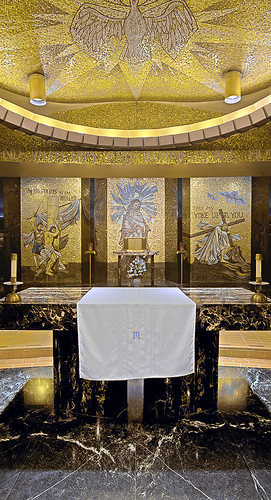
Thursday, June 26, 2008
St. Francis de Sales Oratory Wins “Golden Brick Award”
Renovation efforts at St. Francis de Sales Oratory have now received public recognition with reception of the annual “Golden Brick Award” bestowed by the DeSales Community Housing Corporation. The Corporation, which spun off from St. Francis de Sales parish as a separate legal entity decades ago, gives the award to people and/or projects that have contributed positively to the Tower Grove East and Fox Park neighborhoods. Nominees may include businesses, institutions, or even individuals that have demonstrated a commitment towards improving the neighborhoods.
The project which won the award for the Oratory this year was the renovation of the vesting sacristy in the church building, a renovation which resulted in the replication of a chapel built by St. Louis King of France. Although this represents just one project out of many in the restoration of St. Francis de Sales church and rectory, it was considered significant, especially since the sacristy project was involved in a Papal award, the “Bene Merenti,” recently given to Abbe Alexander Willweber of the Institute of Christ the King Sovereign Priest.
When the Institute was first given the administration of St. Francis de Sales as an oratory three years ago, both the church and rectory—as well as adjoining schools and convent—were in serious states of disrepair. However, the church now displays most of its former glory as the “Cathedral of South St. Louis,” and the rectory has undergone a thorough renovation. Although the adjoining school and convent buildings still await major updating, the work so far has greatly contributed to a general renaissance in the area. Indeed, the Fox Park Neighborhood Association regards the Oratory campus as the “anchor” of the neighborhood.
Fr. Karl W. Lenhardt, Rector of the Oratory, Vice Provincial of the Institute, and Episcopal Delegate for the Implementation of the Motu Proprio,Summorum Pontificum, in the Archdiocese of St. Louis will receive the Golden Brick Award on Wednesday evening, July 9, at 5:30pm in a presentation ceremony at the Tower Grove Abbey (2336 Tennessee).
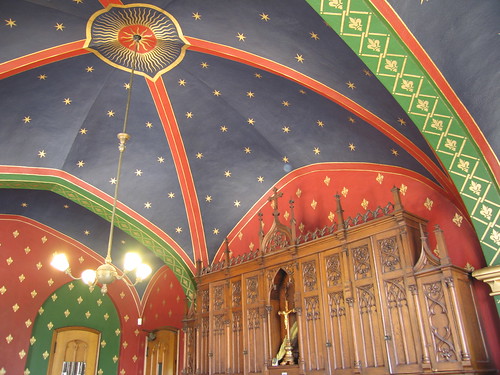
Photo courtesy of the Oratory.
Tuesday, June 24, 2008
Photo of Corpus Christi Church, in Shiloh, Illinois.
Annual Novena to Saint Ann
Address:
4515 Evans Avenue
St. Louis MO 63113
Monday, June 23, 2008
Do Your Own D@!# Research!
"Please tell me where in any public school cirricula it says students ought to use drugs????? Please be very specific! As a Catholic who spent 8 years on a public school board in a community where ther is no Catholic High School I want to see a very detailed response...."What am I? A reference clerk in a library? Your graduate student? Do your own research! Hehehehe....!
But this research is quite easy. Just look up "values clarification". These educational programs are experientially-based and inculcate in students the absolute centrality of autonomous moral choice. While being superficially intellectual, with endless dreary scientific-rationalistic descriptions of drug use and sexual behavior, oftentimes these programs use emotionalism to push a student into a particular direction, such as showing the horrors of botched back-alley abortions. Also, let's not forget that teens usually think of themselves as being bulletproof: to them, bad consequences are for other people; so there is only an upside to this new knowledge of sexual techniques and pharmaceuticals.
"The fact that some people use recreational drugs has led to experiential-based public school curricula telling students that they ought to use these drugs if they so choose."
Sunday, June 22, 2008
Photo of Tabernacle
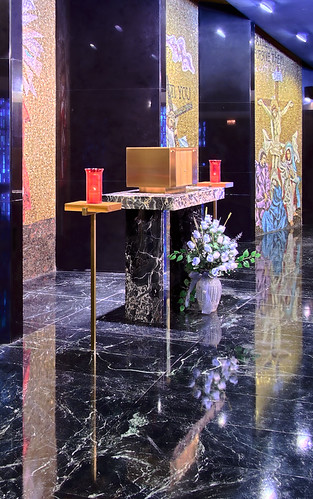
Tabernacle, at Christ the King Chapel, at the Shrine of Our Lady of the Snows, in Belleville, Illinois.
Friday, June 20, 2008
Thursday, June 19, 2008
Wednesday, June 18, 2008
Tuesday, June 17, 2008
Anniversary Mass for the Canons Regular of the New Jerusalem
Saint Michael's Abbey
19292 El Toro Road
Silverado, California 92676
Sunday, June 15, 2008
I Hope All Dads
Saturday, June 14, 2008
Celtic Cross
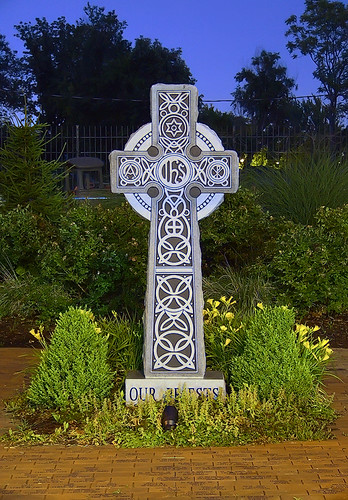
Celtic cross monument at Saint James the Greater Church. Modeled after ancient Irish crosses, this also includes Greek letters of the name Jesus Christ, as well as Alpha and Omega: beginning and end. At the base, obscured by vegetation, it reads "OUR PRIESTS". Surrounding the cross are bricks inscribed with names of church patrons and memorials.
Although technically in the Clayton neighborhood of the City of Saint Louis (as distinguished from the City of Clayton in Saint Louis County), this neighborhood is almost universally called 'Dogtown'. The church is the focal point of an annual Saint Patrick's Day parade.
Friday, June 13, 2008
Cupola at the School Sisters of Notre Dame
Photo of Saint Bernadette Church, in Lemay, Missouri
Thursday, June 12, 2008
Wednesday, June 11, 2008
"Is Google Making Us Stupid?"
The advantages of having immediate access to such an incredibly rich store of information are many, and they’ve been widely described and duly applauded. “The perfect recall of silicon memory,” Wired’s Clive Thompson has written, “can be an enormous boon to thinking.” But that boon comes at a price. As the media theorist Marshall McLuhan pointed out in the 1960s, media are not just passive channels of information. They supply the stuff of thought, but they also shape the process of thought. And what the Net seems to be doing is chipping away my capacity for concentration and contemplation. My mind now expects to take in information the way the Net distributes it: in a swiftly moving stream of particles. Once I was a scuba diver in the sea of words. Now I zip along the surface like a guy on a Jet Ski.If you use mechanical transportation exclusively, your muscles grow soft, and if you use electronic information retrieval — like Google — exclusively, your brain goes soft too.
This article refers to Marshall McLuhan (1911-1980), a professor of English, a convert to the Catholic Faith who read his way into the Church via G.K. Chesterton, and who taught for a while at Saint Louis University. Now, McLuhan was quite a bit more critical of the media than supposed: his "global village", formed by ubiquitous international electronic communications, is largely negative in his view because it has the potential to facilitate totalitarianism.
Tuesday, June 10, 2008
Photos at Saint Mary's High School, in Saint Louis, Missouri
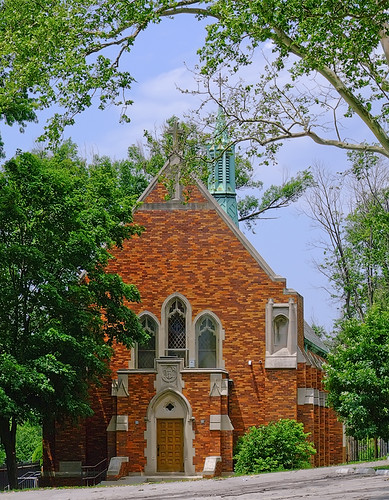
Saint Joseph Chapel.
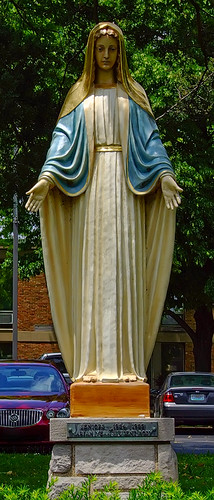
Statue of the Virgin, donated by the Class of 1955.
Monday, June 09, 2008
Sunday, June 08, 2008
Iambic Pentameter
If Only Drawing Were a Gift of Mine -
Some Comic Strips would I prepare for All;
With Robots, Bishops, Talking Cats, and Laughs.
Saturday, June 07, 2008
Pro Patria
The increase of popular power... meant that war now had to be “sold” to the masses in order to ensure their support and prevent domestic unrest. Reasons for war that may have been convincing enough for the upper echelons may not have been convincing enough for the masses to whom they had partly abdicated their authority. The simple war of A versus B was replaced with [that] of a war between Good and Evil. The result of this demagogic shift in concept was for humanity to be restricted to our own side and the enemy to be downgraded to subhuman status.
The very apotheosis of this dehumanization, however, was during the Second World War. The Nazis (partly inspired by American eugenicists) attempted to create a science of determining which men were humans and which were subhuman. In the disgusting process, millions of not only the conquered but even their own German citizens were helplessly slaughtered in consequence, while the citizens of London and other cities were forced to brave the Blitz. The Anglo-American response was scarcely any better. The RAF Bomber Command employed scientists to determine how best to inflict harm upon the enemy populace, not the enemy armies. The result was the firebombing of large urban centers, including purely residential districts, with the directed aim of creating firestorms powerful enough to suck the air from basement raid shelters, thus suffocating innocent women and children in their only protected place.Although improvements in weaponry and a weak spirit of charity has greatly reduced civilian casualties in some recent warfare, the false new definition of patriotism has remained. Nowadays, some claim that a person must accept national political decisions in order to be patriotic, while others condition their patriotism on national virtue.
Only the Fittest Ought to Survive
...After her oncologist prescribed a cancer drug that could slow the cancer growth and extend her life, Wagner was notified that the Oregon Health Plan wouldn’t cover it.Get used to hearing stories like this.
It would cover comfort and care, including, if she chose, doctor-assisted suicide.
Friday, June 06, 2008
Photo of Narthex at Saint Francis Borgia Church
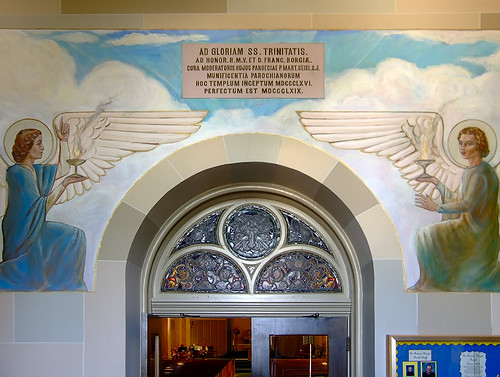
Painting in the narthex of Saint Francis Borgia Church, in Washington, Missouri.
Correction:
To the glory of the Most Holy Trinity, in honor of the Blessed Virgin Mary and of St. Francis Borgia, under the care of this parish's pastor, Father Martin Seisl S.J., thanks to the generosity of the parishioners, this church was started on 1866 and completed on 1869.
Wednesday, June 04, 2008
"Archbishop Raymond L. Burke Confers Papal Medal"
Last Monday, June 2, His Grace The Most Reverend Raymond L. Burke, Archbishop of Saint Louis conferred the Papal Medal “Bene Merenti” on Abbé Alexander Willwebber of the Institute of Christ the King Sovereign Priest for his restoration work on several historic Catholic churches here in the United States. This award is given by the Holy Father himself for outstanding good works for the Church.Abbé Willwebber has been the artistic consultant for several restoration projects entrusted to the Institute of Christ the King all over the world and in the USA, like St. Mary’s Oratory in Wasau, Wisconsin, the Shrine of Christ the King Sovereign Priest in Chicago, Illinois, Old St. Patrick’s Oratory in Kansas City, Missouri, and St. Francis de Sales Oratory here in St. Louis, Missouri. While each of these edifices were designed in a different style—St. Mary’s in American Neo-Gothic, the Christ the King Shrine according to early Baroque churches in Rome, and St. Francis de Sales in German Gothic—the work of Abbé Willwebber has enabled each of the churches to recapture its original beauty.A fine example of Abbé Willwebber’s work is the newly restored North Sacristy of the Institute’s Oratory here in St. Louis. The sacristy, which is the vesting area for the priest before he celebrates Mass, has been restored to resemble a chapel built for St. Louis of France, the patron saint of our city.Archbishop Burke conferred the medal in a short ceremony in St. Francis de Sales’ Rectory at 7:00 p.m., followed by reception for the guest of honor and for Very Rev. Msgr. Gilles Wach, Prior General of the Institute of Christ the King Sovereign Priest; Very Rev. Msgr. R. Michael Schmitz, U.S. Provincial of the Institute, Chicago Illinois; Rev. Father Michael Wiener, Episcopal Delegate of the Extraordinary Form of the Roman Rite, Oakland California; Rev. Father Karl W. Lenhardt, Rector of St. Francis de Sales Oratory, Vice Provincial and Episcopal Delegate of the Motu Proprio, Summorum Pontificum for the Archdiocese of St. Louis; Rev. Father William Avis, Vicar of the Oratory of St. Francis de Sales; and several candidates of the Institute of Christ the King Sovereign Priest.
Father Avis, Msgr. Brier, Msgr. Wach, His Grace, Msgr. Schmitz, Abbé Alexander, Father Lenhardt
His Grace, Msgr. Schmitz, Abbé Alexander, Father Lenhardt
Abbé Alexander, His Grace

Photo taken last night during the Our Mother of Perpetutal Help devotion at Saint Francis de Sales Oratory.
Sunday, June 01, 2008
Photos of Saint Matthew the Apostle Church, in Saint Louis, Missouri
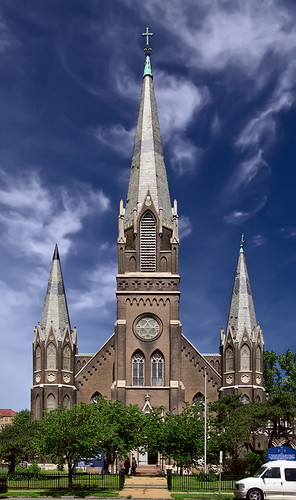
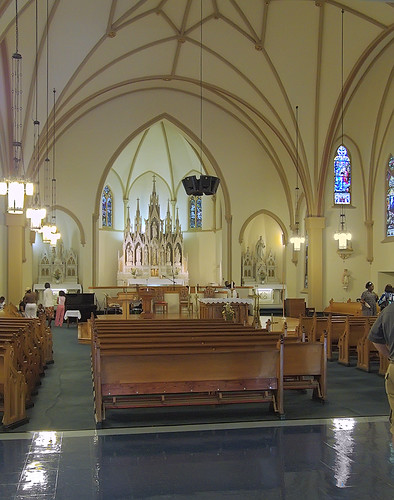
The nave after the end of Mass. This is a fairly small-sized church by City standards, but has nice detail throughout. The Altar of Sacrifice is now located in the center of the transept, but apparently most of the original liturgical furnishings have been retained.

The tabernacle, below a crucifix and the Sacred Heart of Jesus, and above a depiction of the Last Supper, is in the old high altar.
The Cathedral by Candlelight
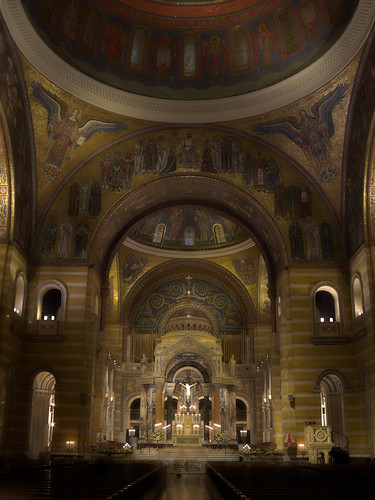
A photo taken after the Corpus Christi procession. The Cathedral Basilica was lit by many candles, as well as by subtle indirect lighting.


